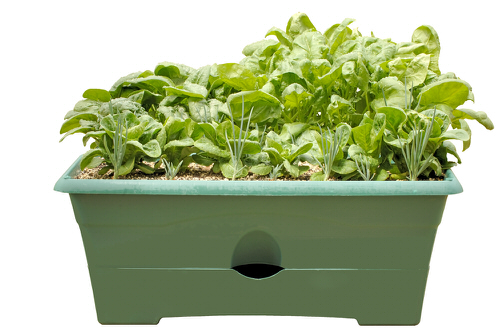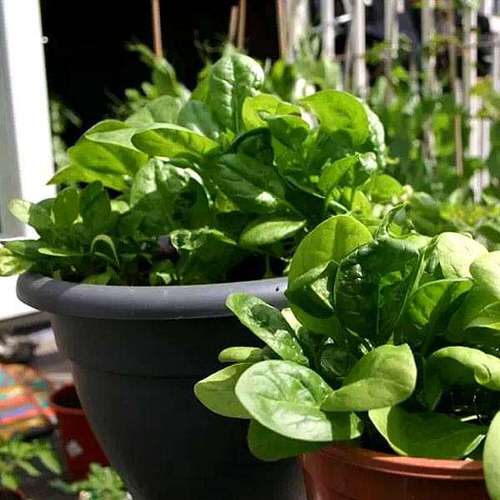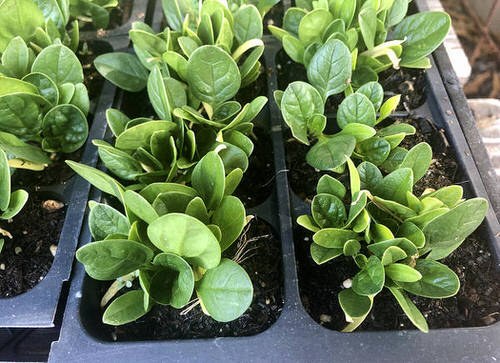Learn How to Grow Spinach in Pots in the easiest way and harvest this nutritious green in your home without having a big garden!

Growing Spinach in Containers is the best way to enjoy a homegrown harvest in a limited spot like a windowsill, rooftop, patio, or balcony. This nutritious leafy green is not difficult if you have a place that receives direct sunlight and space to keep several pots!
Best Spinach Planting Time
While spinach is frost-tolerant and can survive temperatures as low as 20°F (-6.7°C), it’s not optimal for growth. Spinach seeds germinate best in soil temperatures between 45°F (7°C) to 75°F (24°C).
This green vegetable grows optimally in daytime temperatures between 60°F (15°C) and 70°F (21°C). The plant can endure temperatures up to 85°F (29°C) easily, but a higher temperature range may cause it to bolt prematurely and affect its flavor, making it bitter.
It can germinate even when the soil temperature is as low as 40°F (4.4°C) and up to 85°F (29°C); a rise in temperature higher than this can significantly reduce the germination rate. This is because too high or low temperatures can cause the seeds to become dormant, a state known as “thermodormancy.”
Cold Climates (USDA Zones 1-6)
In colder climates, planting should commence in late summer to early fall. This way, the plants enjoy the cooler weather and provide a rich harvest before winter frost arrives.
Temperate Climates (USDA Zones 7-8)
In temperate climates, early spring is an ideal time to plant spinach as soon as the soil is workable.
Second sowing can be done in the fall, about six weeks before the first predicted frost. A late fall planting for an early spring harvest the next year is also a good practice.
Subtropical and Tropical Climates (USDA Zones 9-10)
In such regions, your spinach planting should start in winter or early spring, enabling the plants to provide leafy greens consecutively before the summer heat kicks in. A second planting in late summer or early fall for a fall harvest also works well.
This effectively means you can grow spinach year-round in such climates with the right care and attention.
Hot Climates (USDA Zones 11-13)
For hotter regions, it’s best to plant spinach in late winter or spring and again in fall for a fall and winter harvest. To prevent bolting, it is advisable to provide shade during the hottest part of the day.
Planting Spinach Indoors
For indoor spinach planting, start spinach in late winter and then successively. Make sure it gets 4-6 hours of sunlight (it’s possible if you have a big south-facing window, or to supplement it, place it for 12 hours under grow lights daily). This makes it a year-round crop, irrespective of your outdoor weather conditions.
How to Grow Spinach in Pots?

Growing spinach from seeds is the most detailed process:
Sow seeds 1/2 inch deep directly in containers or a seed tray. Seedlings will germinate in 5 to 14 days. How fast it will depend on the variety and growing conditions.
If you have sown seeds in a seed tray, wait until 2-3 true leaves appear on each plant and then carefully transplant them into the pots.
However, it’s better to plant spinach directly in the desired pots. Also, it’s one of the fast-growing vegetables, and you’ll be ready to start harvesting it within one month after germination.
Best Container Size for Growing Spinach in Pots

Select a pot with a wider mouth that is at least 8 inches deep and as wide as you want. You don’t need a very deep pot, but a wider one. Depending on your space on a patio or balcony, you can also go for wooden boxes, window boxes, railing planters, or crates.
Growing Spinach Indoors
Growing spinach indoors on a windowsill or windowboxes outside the window of your urban home is a great idea, as it doesn’t require full sunlight. You can also place its pot on a kitchen window, balcony, or practically any place where it gets at least 4-5 hours of direct sun.
Spacing Spinach
Provide each spinach plant with 3 inches of space. For example, if you have a 12 inches wide container, you can accommodate 4 spinach plants in it.
If you want to pick large leaves, give a little more space to each plant. Avoid spacing the plants too much or growing them too crowded, as this will result in overly small or large leaves, which will hamper the taste.
Requirements for Growing Spinach in Containers

Position
If you are growing spinach in fall (autumn), keep the plant in a sunny spot in mild climates.
For summer planting, keep your potted plants in a location that receives some shade, especially in the afternoon.
In a tropical, warm, or arid climate (USDA Zones 9-11), place the containers in a spot that receives a bit of shade. The plant will do just fine in partial shade.
Soil
To grow spinach in containers, use a quality potting mix that is rich in organic matter by adding a lot of rotted manure or compost. This will make the texture of the soil more crumbly and loamy.
Avoid a growing medium that clogs the drainage and remains waterlogged. Well-draining soil with a neutral pH is the most crucial factor for the optimum growth of spinach in containers.
Watering
When growing spinach in containers, avoid water stagnation, which can lead to the development of rot and various fungal diseases. Also, avoid wetting the foliage.
Keep the soil moist all the time but not soggy or wet. Make sure the pot has enough drainage holes at the bottom. Always water deeply until it starts to seep out from the holes.
Temperature
Spinach seeds can germinate both in temperatures as low as 40 F (4 C) and in high temperatures. However, the best soil temperature for growing spinach is 50-80 F (10-27 C).
Many spinach cultivars can tolerate temperatures down to 20 F (-6) and up to 90 F (32 C) easily. However, once the temperature starts soaring, you may need to provide shade for your plants. High temperatures also make spinach leaves more bitter and less tastier!
Spinach Care

Growing spinach in pots doesn’t need special care. Regular watering, fertilizing, and the right soil are critical to a great harvest.
Fertilizing
To grow healthy green spinach, you need nitrogen. When planting, mix time-based fertilizer or add 30 percent compost or well-rotted manure to the soil. This will slowly provide nutrients.
Feeding the plant with fish emulsion, compost, or manure tea in the middle of the growth is a nice organic way to promote the plants.
If you have not added slow-release fertilizer, feed the plant with balanced liquid fertilizer once in every 2-4 weeks in half strength.
Mulching
Mulch, even if you’re growing spinach in pots. Organic matter helps plants retain moisture.
Pests and Diseases
While growing spinach in containers, you don’t need to worry much about pests. However, keeping an eye on leaf-eating insects like slugs, caterpillars, and other common garden pests like aphids will help you eliminate them on time.
If you notice pests, simply drench the plant with insecticidal soap or use neem oil, it is safe and better than commercial pesticides.
Super Tips for Growing Spinach in Warm Climates
It is a cool-season crop, but growing spinach in arid, tropical, and hot climates is extremely easy. Moreover, you can grow it successively as a bi-annual crop, except in the hot summer months.
You’ll need to provide shade and enough water to keep the soil temperature cool and moist.
In warm weather, vegetables like lettuce and spinach begin to bolt early and set seeds. One of the most important things you need to consider when growing spinach in hot climates is to grow heat-tolerant varieties.
You can enquire in your area, but some of the best ones we can suggest are Corrente, Canadian Green, Akarenso, Alkame, Samba, and Alrite. These varieties easily tolerate heat and humidity.
Harvesting Spinach

The spinach plant will be ready for harvest 25 to 50 days after germination, depending on the growing conditions and cultivar.
Harvest when the plant has formed at least 5-6 healthy leaves, 3-4 inches long. The best method is the “cut and come again method.” For this, pick the outer leaves first and leave the new inner leaves so that they continue to grow or trim the whole plant at the base with a knife or scissor, and the plant will resprout again.
Note: When the weather becomes humid and hot (in warm climates), the plant tends to form an erect stem on which you can see some small yellow or green flowers developing. To coincide with the flowering and the subsequent production of flowers, the plant’s foliage thickens and changes in flavor (becoming more bitter), which is called bolting. For better taste, it is convenient to harvest the plant before it starts flowering.
How many spinach plants to grow for yourself when growing in pots?
For a substantial harvest, grow at least 12-15 plants for yourself. For a regular harvest, do it successively, every 2-3 weeks. If you’re growing 4 plants in a 12 inches wide planter, you’ll need 3 such pots for 12 spinach plants for normal picking for fresh leaves.



I can’t wait to try this next year. Thanks for posting.
CAN YOU PLEASE SI G ME UP FOR YOUR EMAIL NEWSLETTER.
Just planted spinach. Hope mine looks as good as yours. Thanks for the advice
Spinach is one of my favorite green leafy vegetable aside from moringana & saluyot. Now I have the chance to plant my own spinach. Thank you for the guide.
thank you for the tips………certainly worth a go
There are many benefits of spinach. Spinach is Low in fat and even lower in cholesterol, spinach is high in niacin and zinc, as well as protein, fiber, vitamins A, C, E and K, thiamin, vitamin B6, folate, calcium, iron, magnesium, phosphorus, potassium, copper, and manganese. In other word, it’s loaded with good things for every part of your body!
Thanks for your article.
Very intersting. Will try to do this ver soon.
Excited to try this! Please add my email to your newsletter list!
what month is the best time to plant spinach indoors in Hawaii?
Ive planted outdoors before and i can not keep up with the pest.
Thanks
Thanks
Thanks for the guide for planting spinach. I am vegetarian and love to eat organic vegetables.
I am now interested to plant my own spinach.
Thanks again for the informations
Oh! Wonderful, I may try this soon as well! Awesome post :D
This is explained so well, thank you for all of your tips. I love growing in pots because it means my kids can get involved and take charge of their own plants (without ruining my garden!) and I’m always on the look out for new things for them to grow. I’ll definitely be trying this next. Hopefully it’ll trick them into eating it too!
Thanks again
Eric
Hey eric, you should’ not have to trick them.Introduce them to spinach cakes. Sauteed chopped bacon( to reduce grease) 0r chopped ham or sausage finely chopped, seasoned . Sautee spinach ,mix with chopped ingredients, add a portion of flour to bind mixture. Pinch portion and form into a patty, place on non stick pan and bake at 300 for 20 mins. Never mentioned the work spinach, and hooked.
Thanks for the nice piece,helps much
Thank you so much. I am working on it right now.
I like to receive your newsletter please.
Thanks again,
Thank you so much for sharing in an understanding manner,I live in MT so I have began planning for the next planting season.I can’t start soon enough,thank you.
I have planted few seeds in a wide pot and it did germinate well. But, all of a sudden it started to fall off. Would there be a reason or care I’m missing?
How deep was the pot that the plant was in? & how many “few seeds” did you plant in that pot? Also, was there any bugs in the area that could’ve gotten into the plant?
exellent
This was really helpful. I’ll give it a try this winter indoors. Thanks!
May I know how many seedlings do you plant in the 6″ deep pot? How many seeds per hole do you recommend if I plant using the seed tray?
Thanks.
Aw
Thanks for the tips for warmer climate varieties of Spinach. I will have to look at some Asian varieties since we are in NC. Where are all you planting?
My spinach plants are growing to about 3-4 inches long and then just falling to the sides. It looks like the plants are falling because unable to hold their own weight. I’ve tried sowing them deeper too with pretty much same results. What can I do differently?
I can’t wait to starts my veggies garden,this year I got some heirloom tomatoes seed and I got big containers for them.Thank for the hints, I had learned a lot.
This is so thoroughly yet concisely written and easy to understand that it actually makes me believe that even I would be able to follow these directions. Thank you so much for posting.
Thank you very much for sharing the information. Please add my e mail. and send news letters.
Alternatively, you can keep your pot outdoors after seeding, as long as the ground has thawed. Even though you aren’t planting the spinach in the ground, this is a good indicator that your spinach could survive outside. Spinach can survive temperatures as low as 15 °F (?9 °C).
Thanks for your help and am working on it now to earn income 🙏🙏
Love this stuff ! As I was working on getting more things about this, the article has helped me to solve various clarifications. Thanks for the great content.
I don’t have much of a green thumb. This might be a good place for me to start.